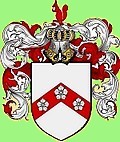 THE GILBERT FAMILY HISTORY
THE GILBERT FAMILY HISTORY
Sussex Calvinistic Chapels linked to the family
Website created by Richard Gilbert, last updated 15 February 2021.
MAIN NAVIGATION MAP
GILBERT; Waldron 1700s & earlier
|
HASSELL; Waldron --
GILBERT; Waldron 1800s --
GILBERT; to the USA
|
SODDY; Sussex & London --
GILBERT; Eastbourne 1800s --
MORRIS; Lewes & Eastbourne
|
HEWITT & HEDGEGOTT --
GILBERT; Eastbourne 1900 onwards --
CLEMENTSON; London
|
GILBERT; in the USA
Six non-conformist chapels in East Sussex have links to the Gilbert and Morris families, in varying degrees, and they are listed below in order of the date of construction. These links will connect you directly;
Five Ash Down Chapel, Uckfield (1784 to present day)
Jireh Chapel, Lewes (1805 to present day)
Heathfield Chapel, Punnett's Town (1807 to present day)
Tabernacle Chapel, Lewes (1817-1954)
John Grace's Chapel, Eastbourne (1822-1892)
Cavendish Place Chapel, Eastbourne (1857 to present day)

FIVE ASH DOWN CHAPEL, UCKFIELD
===============================
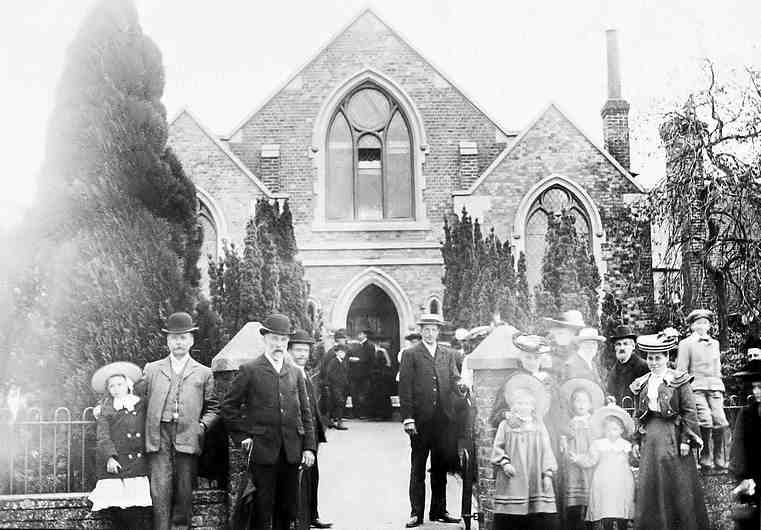
Five Ash Down Chapel, around 1900.
Calvinistic Independent Chapel. Still standing, now an independent Evangelical Church in the Reformed (Calvinist) tradition.
Five Ash Down, Uckfield, East Sussex.
Thomas Dicker of Five Ash Down, recognising that there was no venue locally where a Calvanistic gospel could be heard, opened his home for public worship in 1773, despite scorn and hostility. After about ten years he gave a piece of land adjoining his house for the purpose of building a chapel, which was soon erected and opened in the spring of 1784. The church was run along Cavinistic lines at first, and it has been described as "the parent of many other places [of worship] both Baptist and Independent" across Sussex. Today it continues as a small Evangelical fellowship, still worshipping in the original chapel, although expanded and refronted (in Gothic Revival style) in Victorian times when further land was acquired enabling a Sunday School to be built.
In 1878 the ministry of Mr Thomas Martin began, and this was to last for more than 41 years until, in 1920, he was called to the pastorate of Providence Chapel, Brighton. Sadly he died only two years later and is buried at Five Ash Down. Thomas Martin gave an address at the funeral of Rev A J Baxter in Eastbourne on 6 March 1908.
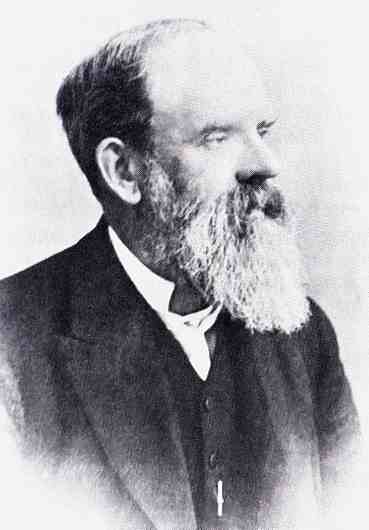
Thomas Martin.
When James Berry Morris built "Fernhurst" (in 1899) and Ellen I Gilbert bought "Ryderswells" (in 1905) - both in London Road, Uckfield - Five
Ash Down Chapel was their nearest place of worship, and Thomas Martin would have been the Minister.
Thomas Martin conducted the funeral of Reginald Morris (1862-1909) in Eastbourne.
 More details of the Morris and Gilbert families in Uckfield, and their
involvement with the Chapel.
More details of the Morris and Gilbert families in Uckfield, and their
involvement with the Chapel.
William Gilbert (1823-1874) was buried in the churchyard at Five Ash Down Chapel but, since he lived in Portsea, Hampshire, we don't know why.

JIREH CHAPEL, LEWES
====================
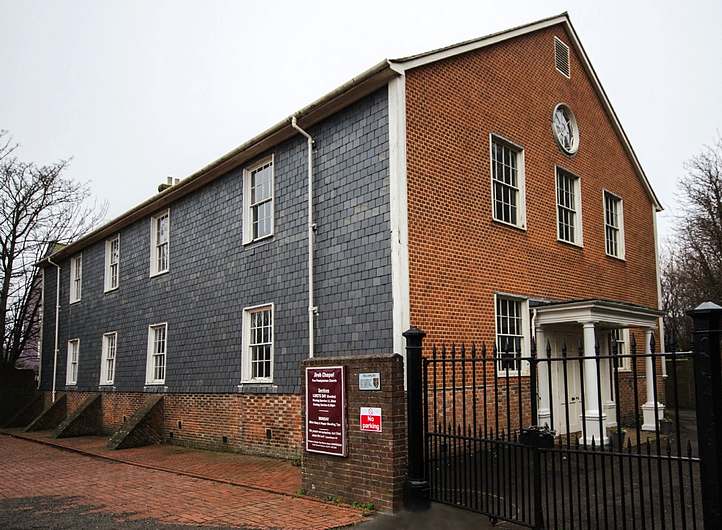
Jireh Chapel, Lewes.
A Calvinistic Independent Chapel. Still standing, now a Free Presbyterian Church.
26 Malling Street, Lewes, near the 'Tesco Roundabout'.
Built in 1805 in the American Colonial style, Jireh Chapel is mostly of timber contruction. It has Welsh slate on the south side, weather tiles on the west side and local "mathematical tiles" on the other two faces. It is founded on chalk and has a roof held together with wooden pegs. The cast iron entrance arch was made by E Morris & Son ironfounders.
The chapel was built for the Rev. Jenkin Jenkins W.A. (Welsh Ambassador of God's truth) who had been the minister of the Countess of Huntingdon's chapel on the hill (the road leading up to the golf course, now Chapel Hill, formerly East Street), known as Cliffe Chapel. He had probably been dismissed by the trustees of that chapel when he espoused the high Calvinistic doctrine which was preached by his friend William Huntington. William (1745-1813) was a famous preacher and evangelist who preached at Providence Chapel, Grays Inn Lane, London during the latter part of the Evangelical Awakening of the 18th and 19th centuries. His preaching tours brought him frequently to both Sussex and Kent. His tomb is in the yard at the rear of the chapel.
In 1804 Jenkins bought the land on which Jireh Chapel is built, and it was opened by William Huntington on 7 July 1805. Cliffe Chapel then became known as 'The Old Chapel'. In 1816 some wealthy members of the Old Chapel (including Charles Wille and Nehemiah Wimble) put forward a plan to build the Tabernacle Chapel on land owned by Wille (see below). The Old Chapel was eventually replaced by a Presbyterian Church in Market Street (probably the site of the present Flea Market), and the Old Chapel was sold and demolished. The proceeds were divided between the Jireh Chapel and the Tabernacle Chapel, each receiving £54.
Pastors; Rev Jenkins (1805-1810), John Vinall (1811-1857), John Vinall jnr (1857-1859), Rev Matthew Welland (1859-1907). John Grace (see
further down this page) preached here for John Vinall.
John Vinall snr married Mary Jane Morris at the chapel in 1853.
The following family members (and maybe others) were apparently baptised at Jireh Chapel;
Hannah Morris (1790), Mary Morris (1792), Martha Morris (1794), William Morris (1796), Rebecca Morris (1798), Benjamin Morris (1799),
Ebenezer Morris (1802), Deborah Morris (1803), Joseph Morris (1806), Ann Morris (1808), Thomas Morris (1813), Elizabeth Morris (1816),
Benjamin Morris (1818), George Morris (1822), Ebenezer Morris (1825), Joseph Morris (1826), James Berry Morris (1828), Mary Jane Morris
(1829), Benjamin Morris (1831), Lydia Ann Morris (1832), Sarah Morris (1834), Stephen Morris (1836).
I couldn't understand how the first eight of those names could have been baptised at the Chapel before it was built! However Peter Trent pointed out that when Rev Jenkin Jenkins moved from Cliffe Chapel to the new Jireh building in 1805 he took the baptismal roll from the Cliffe Chapel with him.
Ebenezer Morris was a trustee and had been a deacon for over 50 years at his death in 1888.
Pastor Rev Matthew Welland preached his first sermon on 11 August 1844 at a chapel in Surrey, arriving at the Jireh Chapel in July 1859, becoming the Pastor a month or two afterwards. He preached his last sermon at the Chapel on Christmas Day 1907, aged 90.
The church was designated a Grade I Listed building on 25 February 1952. After the ministry of Rev Herbert Moore, who served from 1931 to 1965 the chapel fell into disuse and decay but was restored with the aid of funds from the English Heritage Trust in the mid 1990s. It was handed over to the Free Presbyterian Church in April 1998. However since 2005 Jireh Chapel has been without a resident minister. Jireh Chapel is now one of seven 'Free Presbyterian Church of Ulster' places of worship in England.

HEATHFIELD CHAPEL, PUNNETT'S TOWN
===================================
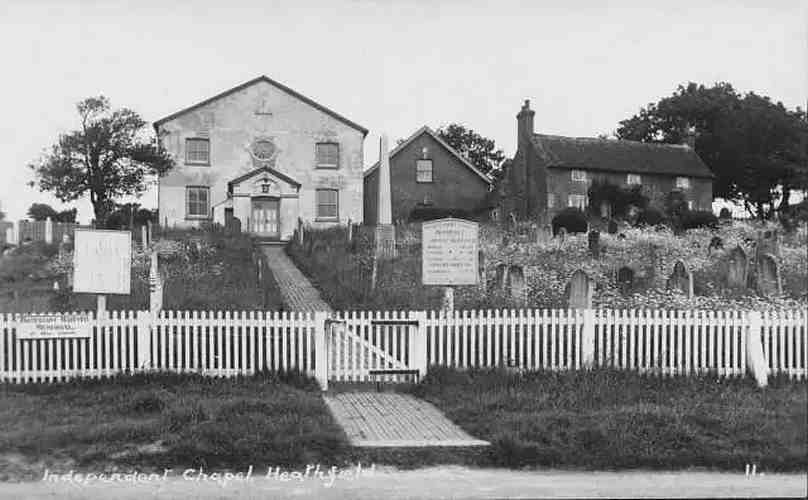
Heathfield Independent Chapel, from a post card.
A non-conformist evangelical chapel. Still standing.
B2096 Battle Road at Chapel Cross, Punnett's Town, Heathfield. Also known as the "Cade Street Chapel" or the "White Chapel".
Rev George Gilbert (1741-1827) was an independent Calvinist preacher, born in Rotherfield. He had been a distinguished soldier for General Elliott of Heathfield abroad from 1759, returning to England in 1763 and leaving the army in 1779. He preached in many villages around Sussex ("forty different parishes", it was claimed) and set up churches in many of them, including the Independent Church at Heathfield in 1807 at which he became Minister. He built the adjoining house for his family, and died in 1827 at the aged of 86.
Mercy Errey (1802-1851) who married Thomas Gilbert (1791-1851) and emigrated to USA, was baptised here in August 1802.
George belonged to an extensive Gilbert family in the Rotherfield and Heathfield area, at the same time as the Gilbert family featured on this website was nearby at Heathfield and Waldron. It is quite likely that there was a link between the two groups, although I have not yet found it. I will continue to search, and very much hope that we will turn out to be related to George and linked to his Chapel.

TABERNACLE CHAPEL, LEWES
==========================
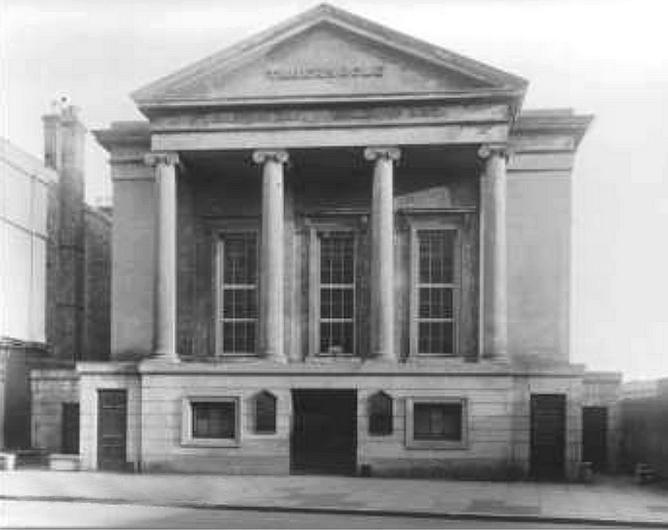
Lewes Tabernacle.
Calvinistic Congregational Chapel. Demolished in 1954.
Cliffe High Street, Lewes, roughly where Superdrug stands now in the precinct, close to the Ouse bridge.
Lewes Congregational Tabernacle was built in 1818 as a meeting house for local prosperous non-conformists, although the first minister, Evan Jones from Wales, was not appointed until 1829. Trustee Charles Wille (1768-1849) of Ryders Wells, Wellingham, travelled to Wales to offer Jones the appointment. The site had been a gift from Charles Wille snr, but the cost of the building was advanced as a loan by Charles Wille snr and jnr, and Nehemiah Wimble. A financial tangle was eventually resolved by forming a Trust in 1828.
The first Trustees were;
Charles Wille snr and Charles Wille jnr (South Malling timber merchants), Nehemiah Wimble (gent. and proprietor of The Friars), Arthur Morris
(grocer of Cliffe), James Berry (South Malling architect and builder, who married Charles Wille's daughter). All of those are related to the
family and details appear within this website.
Also George Adams (senior Constable of Lewes) and his son John Adams (broker), Thomas Weeden (gent.) and John Harvey (brewer,
wine and spirit merchant of Cliffe).
John Morris Wille (1829-1877) was baptised here in 1829, and Mary Sophia Wille (1831-1916) was baptised here by Rev Evan Jones in 1831.
The building was extended to the south in 1832 including a schoolroom, and the Ionic portico was added. The Tabernacle was licenced for weddings in 1838. Plaques commemorating Charles jnr., Charles snr., and his father George Wille (1738-1817) were erected in the chapel. Curiously all three of them lived to be 80.
With declining congregations the chapel was closed, and demolished in 1954 to be replaced by Liptons supermarket, and then by Superdrug.

JOHN GRACE'S CHAPEL, EASTBOURNE
==================================
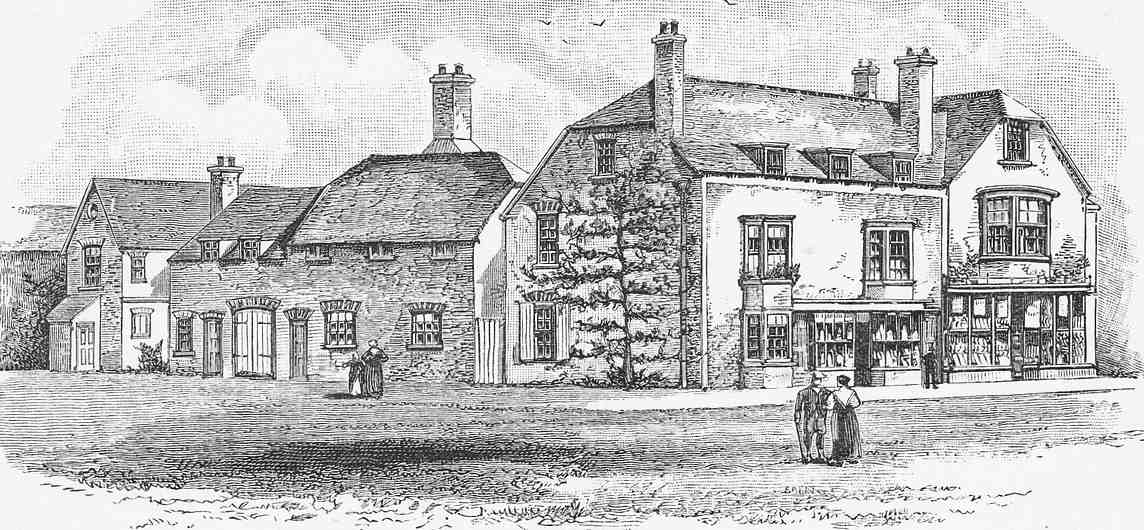
Engraving showing Grace's Chapel on the extreme left, and what would later become Gilbert's Bakery on the right.
Calvinistic Independent Chapel. Demolished in 1892.
Near where Bourne Street meets Seaside Road, Eastbourne, on a site now occupied by Bourneside Court.
Built by John Grace in 1822 alongside his bakery business (which was later to become Gilbert's Bakery).
The requirement for larger premises resulted in the opening of nearby Cavendish Place chapel in May 1857.
The old chapel was then used as a storeroom until 1892-3 when it was demolished.
 More information about the family of John Grace
More information about the family of John Grace
About 1821 John Grace (1800-1865) started holding chapel meetings, first at his home and then in his bakehouse for a Calvinistic and Independent congregation. He and his wife were baptised by Strict Baptist William Crouch in a pond at the rear of Green House Farm, Wadhurst in 1822, and he then built a chapel beyond the bakehouse in 1822-23 seating about 100. The former stable between the bakehouse and the chapel was converted into a cottage for the chapel keeper, with one room serving as a vestry.
At the same time he ran a fishing boat, and he soon began to run short of money, borrowing from his uncle William in 1823 with the bakery building as security. But by 1826 he was declared bankrupt. Hanningtons took him on as an employee, and the Graces departed for Brighton, fully resolved to return to Eastbourne again - but they never did. In 1827, pressure from creditors resulted in John's committal to jail for debt. However he was released later that year and resumed working for Hanningtons.
On the death of John's first wife Mary in 1838, he married the niece (Eliza Verrall) of his friend Ebenezer Morris (1801-1888). John continued preaching in Brighton until his death on 3 March 1865. Grace was regarded as an Independent Baptist minister but, at the time, Strict Baptists and Independents were both considered to be Calvinists. Meanwhile the bakery was leased by David Gilbert (1825-1916) in 1856, and later all the buildings were bought by him.
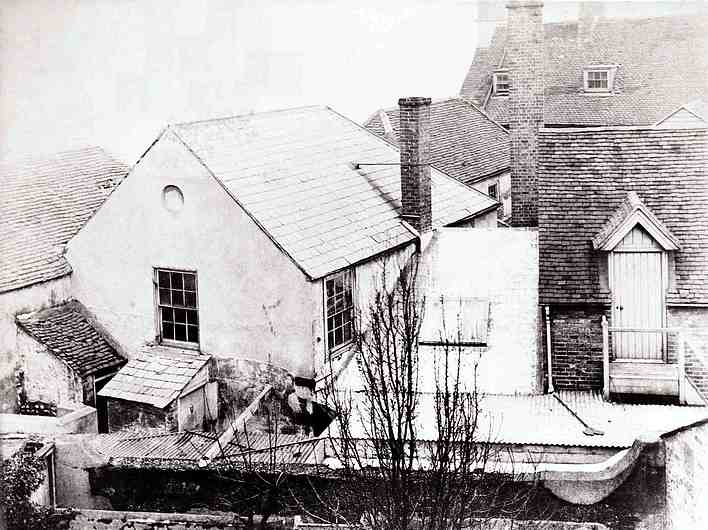

This historic photo, taken by A J Isard, 46 Seaside Road, Eastbourne, is probably the last ever taken of the Grace Chapel, dominating the
left of the picture. It seems to have been taken from the upper floor of No.1 Bourne Street, whose garden wall and gate is just visible at
the very bottom of the photo. The passage into which the gate opens, turns at the extreme right and leads into Bourne Street. All these buildings
were pulled down in 1892-93 to make way for major redevelopment incorporating the new Gilbert Bakery. Compare this with the picture above.
By 1856 the Independent congregation was strong enough to build their own chapel (in North Street, later renamed Cavendish Place) which was opened in 1857, after which the Grace Chapel became a storeroom. The Strict Baptists then approached Grace for permission to use the old chapel, but the request was declined and the building remained as a storeroom until demolition in 1892-93 to enable major development of the area by David Gilbert's son, also David, in order to build a much larger bakery. The pulpit of the old chapel was used in the Sunday School room of the new Cavendish Place Chapel as the superintendent's desk until at least 1930.

CAVENDISH PLACE CHAPEL, EASTBOURNE
=====================================
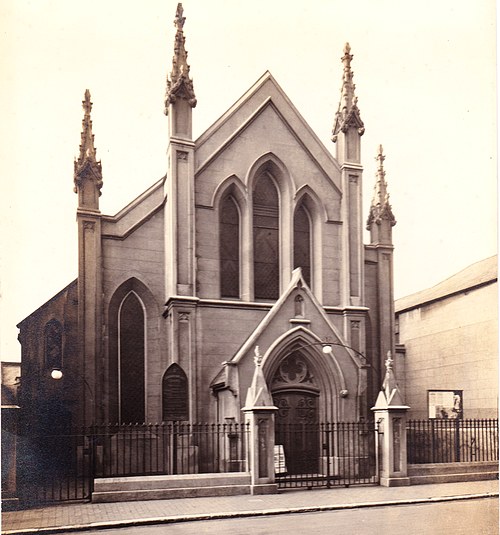
Cavendish Place Chapel around 1925. Photo by G & R Lavis, 71 Terminus Road, Eastbourne.
Calvinistic Independent Chapel. Still standing, now the Greek Orthodox Church of Saint Panteleimon and Saint Theodoros.
30 Cavendish Place, Eastbourne.
John Grace built a chapel alongside his bakery business in Seaside Road in 1822, but the requirement for larger premises resulted in the opening of Cavendish Place chapel on 15 May 1857. John Grace preached at the new chapel in June 1857.
The building was said to have been designed by James Berry, surveyor to the Duke of Devonshire, and the builder was said to be John Haine, founder of the funeral directors still trading in South Street, Eastbourne. Haine is also believed to have built 'Cavendish Villa' directly to the north of the Chapel (known initially as 'Salem Villa' and then 'Bijou Villa' for a short while). When the Chapel was first opened Cavendish Villa was occupied by the first Minister, Benjamin Tatham. When he died in 1866, it continued to be owned by his widow, although she did not live there, but Minister Andrew J Baxter moved there around 1882. Haine also arranged Baxter's funeral when he died in 1908.
Andrew Baxter conducted the marriage of Mary Gilbert (1857-1942) to Benjamin Soddy here in 1880, and David Gilbert (1861-1902) to Ellen I Morris in 1884.
The pulpit of the old Grace chapel was used in the Sunday School room of the new Cavendish Place Chapel as the superintendent's desk until at least 1930. The railings and gate at the front of the Chapel were made by E Morris & Son at their Lewes foundry.
An organ was installed at the Chapel in 1885 for about £100. The money was apparently raised unofficially from friends and acquaintances of David Gilbert junior, the first organist. It was built by H Farrant of Brighton (believed to be the only pipe organ in the denomination) and was first played on 11 October 1885. Later improvements to the organ included an 8 foot gamba, and the lowest octave of the octave coupler which was added by David Gilbert's son Richard Gilbert in 1914.
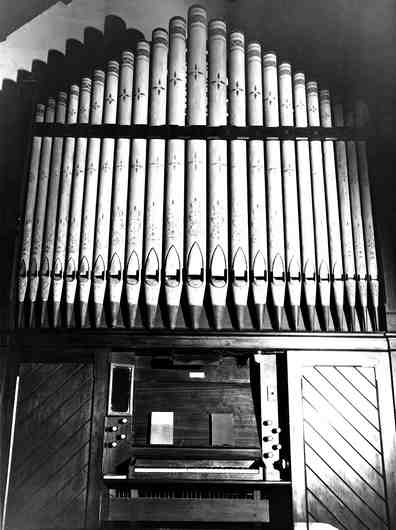

The organ at Cavendish Place Chapel. Photo by Lawrence Stevens 1974.
Rev Andrew Joseph Baxter (1834-1908) became Pastor in 1867 as the Chapel's second minister, and remained there for 40 years. He started out as an engraver with his uncle in London and some of his first engravings were shown at the Great Exhibition of 1852. He then entered the ministry and preached in London, later moving to a church in Nottingham, and eventually coming to Eastbourne in 1867. Andrew became a prolific writer on religious topics and claimed to be able to read the Scriptures in Hebrew, Chaldee and Greek, despite never having had a college education.
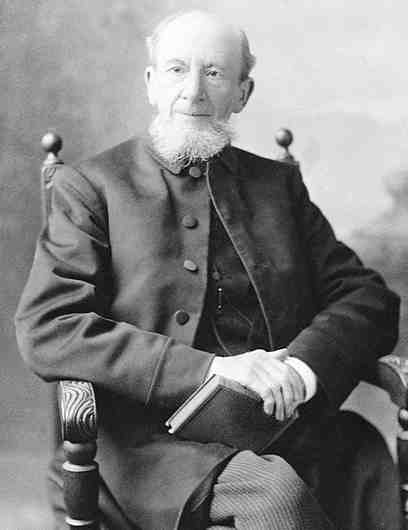
Rev Andrew J Baxter, Pastor at Cavendish Place Chapel for 40 years. Photo by G & R Lavis, Eastbourne.
Andrew Baxter died on 29 February 1908 aged 75 after a long illness. He was buried at Ocklynge Cemetery on 6 March 1908. He left a widow and a daughter who acted as deputy organist at the Chapel. William Mountshire Evans became the new pastor in 1912, remaining in office for 45 years.
Trustees in 1906, David Gilbert (Deacon), James Worley (of Elmwood, Arundel Road), Harry Hillman (Deacon), J Hillman,
Clement J Vinall (Hon. Treasurer).
Cavendish Place was originally called North Street, and Richard Gilbert noted in 1974 that the chapel still possessed crockery bearing the inscription "North Street Chapel". The Chapel closed in June 1985, but reopened in 1990 as the Greek Orthodox Church of Saint Panteleimon and Saint Theodoros.
